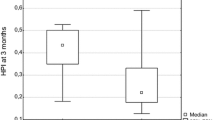Abstract
Hepatic metastases are arterially supplied, resulting in an elevated hepatic perfusion index (HPI). The purpose of this study was to use dynamic contrast-enhanced (DCE) MR imaging to quantify the HPI of metastases and the liver before and after treatment with a novel antiangiogenic drug. Ten patients with known metastatic liver disease underwent DCE-MR studies. HPIs of metastases and whole liver were derived using regions of interest (ROIs) and calculated on a pixel-by-pixel basis from quantified changes in gadopentetate dimeglumine (Gd-DTPA) concentration. The HPI measurement error prior to treatment was derived by the Bland-Altman analysis. The median HPI before and after treatment with antiangiogenic drug BIBF 1120 were compared using the Wilcoxon signed rank test. Prior to treatment, the median HPI of metastases, 0.75 ± 0.14, was significantly higher than that of the whole liver, 0.66 ± 0.16 (p < 0.01). Bland-Altman reproducibility coefficients of the median HPI from metastases and whole liver were 13.0 and 5.1% respectively. The median HPI of metastases decreased significantly at 28 days after treatment with BIBF 1120 (p < 0.05). This pilot study demonstrates that HPI determined using quantified Gd-DTPA concentration is reproducible and may be useful for monitoring antiangiogenic treatment response of hepatic metastases.






Similar content being viewed by others
References
Miles KA, Hayball MP, Dixon AK (1993) Functional images of hepatic perfusion obtained with dynamic CT. Radiology 188:405–411
Kissel A, Rixe O, Methlin A, Nabet M, Tranquart F, Rubini B, Jafaar S, Gaucher H (2001) Quantification of hepatic arterial and portal venous flow using ultrasound contrast agents for early detection of liver metastases of colorectal cancers. J Radiol 82:1621–1625
Fowler RC, Harris KM, Swift SE, Ward M, Greenwood DC (1998) Hepatic Doppler perfusion index: measurement in nine healthy volunteers. Radiology 209:867–871
Blomley MJ, Coulden R, Dawson P, Kormano M, Donlan P, Bufkin C, Lipton MJ (1995) Liver perfusion studied with ultrafast CT. J Comput Assist Tomogr 19:424–433
Sarper R, Fajman WA, Tarcan YA, Nixon DW (1981) Enhanced detection of metastatic liver disease by computerized flow scintigrams: concise communication. J Nucl Med 22:318–321
Leveson SH, Wiggins PA, Giles GR, Parkin A, Robinson PJ (1985) Deranged liver blood flow patterns in the detection of liver metastases. Br J Surg 72:128–130
White MJ, O’Gorman RL, Charles-Edwards EM, Kane PA, Karani JB, Leach MO, Totman JJ (2007) Parametric mapping of the hepatic perfusion index with gadolinium-enhanced volumetric MRI. Br J Radiol 80(950):113–120
Totman JJ, O’Gorman RL, Kane PA, Karani JB (2005) Comparison of the hepatic perfusion index measured with gadolinium-enhanced volumetric MRI in controls and in patients with colorectal cancer. Br J Radiol 78:105–109
Mross K, Gmehling D, Frost A, Baas FJ, Strecker R, Hennig J, Strecker P, Stefanic M, Stehle G, Rossi Ld (2005) A clinical phase I pharmacokinetic (PK) and pharmacodynamic study of twice daily BIBF 1120 in advanced cancer patients. 41st Annual Meeting of the American Society of Clinical Oncology (ASCO), Orlando
Hilberg F, Tontsch-Grunt U, Colbatzky F, Heckel A, Lotz R, van Meel JCA, Roth GJ (2004) BIBF 1120 - a novel, small molecule triple angiokinase inhibitor: profiling as a clinical candidate for cancer therapy. Molecular Targets and Cancer Therapeutics, 16th EORTC-NCI-AACR Symposium, Geneva, Switzerland
Pedersen M, Klarhofer M, Christensen S, Ouallet JC, Ostergaard L, Dousset V, Moonen C (2004) Quantitative cerebral perfusion using the PRESTO acquisition scheme. J Magn Reson Imaging 20:930–940. DOI 10.1002/jmri.20206
Hittmair K, Gomiscek G, Langenberger K, Recht M, Imhof H, Kramer J (1994) Method for the quantitative assessment of contrast agent uptake in dynamic contrast-enhanced MRI. Magn Reson Med 31:567–571
Bland JM, Altman DG (1986) Statistical methods for assessing agreement between two methods of clinical measurement. Lancet 1:307–310
Padhani AR (2002) Functional MRI for anticancer therapy assessment. Eur J Cancer 38:2116–2127
Cuenod C, Leconte I, Siauve N, Resten A, Dromain C, Poulet B, Frouin F, Clement O, Friya G (2001) Early changes in liver perfusion caused by occult metastases in rats: detection with quantitative CT. Radiology 218(2):556–561
Galbraith SM, Lodge MA, Taylor NJ, Rustin GJ, Bentzen S, Stirling JJ, Padhani AR (2002) Reproducibility of dynamic contrast-enhanced MRI in human muscle and tumours: comparison of quantitative and semi-quantitative analysis. NMR Biomed 15:132–142
Meijerink MR, Cruijsen H, Hoekman K, Kater M, Schaik C, Waesberghe JHTM, Giaccone G, Manoliu RA (2007) The use of perfusion CT for the evaluation of therapy combining AZD2171 with gefitinib in cancer patients. Eur Radiol 17:1700–1713. DOI 10.1007/s00330–006–0425–9
Acknowledgements
We would like to thank Cancer Research UK (C1060/A808/G7643) and EPSRC [GR/T20434/01 and GR/T20427/01(P)] for supporting this study and the MRI radiologist (Dr. A. Tang) and radiographers (J.J. Stirling and T. Wallace) involved for their help with the MRI examinations and patient care. The paper includes MRI trial data from a study sponsored by Boehringer Ingelheim, Ingelheim, Germany.
Author information
Authors and Affiliations
Corresponding author
Rights and permissions
About this article
Cite this article
Miyazaki, K., Collins, D.J., Walker-Samuel, S. et al. Quantitative mapping of hepatic perfusion index using MR imaging: a potential reproducible tool for assessing tumour response to treatment with the antiangiogenic compound BIBF 1120, a potent triple angiokinase inhibitor. Eur Radiol 18, 1414–1421 (2008). https://doi.org/10.1007/s00330-008-0898-9
Received:
Revised:
Accepted:
Published:
Issue Date:
DOI: https://doi.org/10.1007/s00330-008-0898-9




